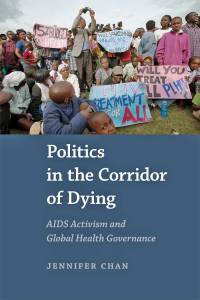Guest post by Jennifer Chan
How do you write about a topic on which over 100,000 journal articles, books, conference papers, scientific reports, government plans, and United Nations documents have already been published? The question nagged at me for months. The subject of AIDS seemingly swelled by the day.
What angle should I take? Which data should I privilege? What should I drop? Which theory is the most appropriate? How many chapters do I need to write? Eleven? That’s too many, I thought to myself. These days, no one would read a 500-page book on AIDS. The times have changed. Now, there are good antiviral drugs, and in many countries, people with AIDS live a relatively healthy life. Drug prices have come down so much that it’s almost hard to scream at Big Pharma anymore. And the public—donors, the UN, governments, scientists, researchers—have moved on to some other health crisis: maternal and child health; health innovation; health systems. Gone is the era of vertical funding, of disproportionate and distorting funding on any one specific disease such as AIDS.
The data must have been fed up with my staring at it for months on end: finally, it seemed to skip my brain and walk straight up to the keyboard. The book was written—poured out—within two months (don’t ask how much time I took to revise, though!).
Coming up with the title (Politics in the Corridor of Dying) was a different story. Those six words consumed many minutes, hours, and days of my waking time and my insomniac nights. I toyed with so many versions that I couldn’t keep track. One day, while walking back to my hotel after an interview with a Russian activist from the underground patient control movement, I chanced upon a tiny museum on a quiet street of St. Petersburg. On the brick wall at the entrance hung a poster scribbled with the word “necrorealism.” My curiosity was piqued. I am a big fan of contemporary and abstract art and know a bit about abstract expressionism, Dadaism, minimalism, and even nouveau réalisme, but I had never heard of necrorealism.
After researching the movement, I discovered a phrase that became my natural title. The “corridor of dying,” according to Vladimir Kustov, a founding member of necrorealism in 1970s Russia, refers to the interval between life and death, that unrepresentable purgatory.
Both the movement and its art was an epiphany for me. The stark necrorealist paintings and black-and-white film footage that I saw in the museum helped me visualize the long corridor of dying that we have been collectively traversing during the past 30 years of the history of AIDS.
Passing through dilapidated labs, lethargic ministries of health, shiny pharmaceutical company boardrooms, complacent UN secretariats, and the hustle and bustle of clinics and NGO offices, AIDS activists fought hard and made some significant gains. What they have done involves more than learning and appropriating the language of science to be on par with the experts; decrying Pharma greed; challenging an outdated UN governance structure; and, when necessary, pointing fingers at themselves as community “experts.”
There really is only one argument that I want to make in this book (which, by the way, was eventually compressed into merely 268 pages, coming to under 10 pages per year of AIDS history, in case you are looking for quick reads on world affairs!). Beyond the concrete gains that the movement realized in terms of increased funding, treatment access, and millions of lives saved and prolonged, the single biggest achievement of AIDS activism over the past three decades lies in the fact that the movement has exposed the fundamental legitimation crises of four contemporary regimes of power: scientific monopoly, market fundamentalism, governance statism, and community control. Activists have cracked open the formerly closed doors of knowledge and power networks and forcing them to diversify and democratize.
This is obviously a contentious argument to make. Is the glass half full, or half empty? Have activists brought some fundamental changes to global health governance, or have they failed? Let me hear your thoughts! Welcome to the corridor of dying . . .
 Jennifer Chan is an associate professor in the Institute for Gender, Race, Sexuality, and Social Justice at the University of British Columbia. She is the editor of Another Japan Is Possible: New Social Movements and Global Citizenship Education and the author of Gender and Human Rights Politics in Japan: Global Norms and Domestic Networks. Her most recent book is Politics in the Corridor of Dying: AIDS Activism and Global Health Governance.
Jennifer Chan is an associate professor in the Institute for Gender, Race, Sexuality, and Social Justice at the University of British Columbia. She is the editor of Another Japan Is Possible: New Social Movements and Global Citizenship Education and the author of Gender and Human Rights Politics in Japan: Global Norms and Domestic Networks. Her most recent book is Politics in the Corridor of Dying: AIDS Activism and Global Health Governance.


